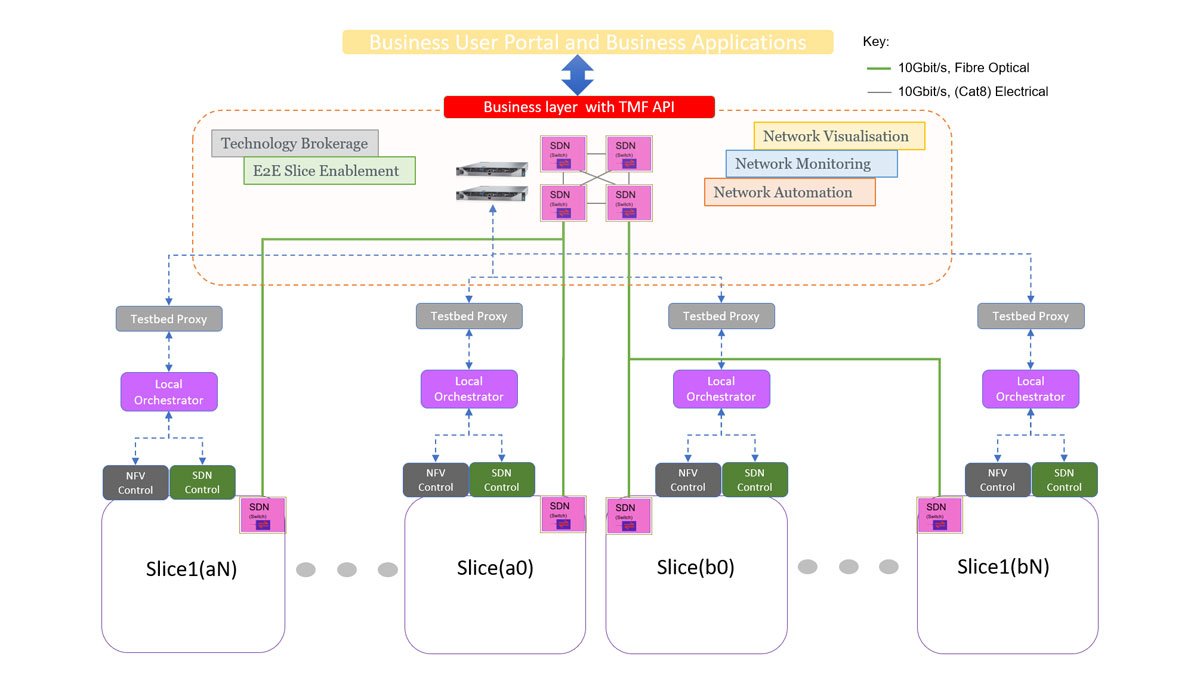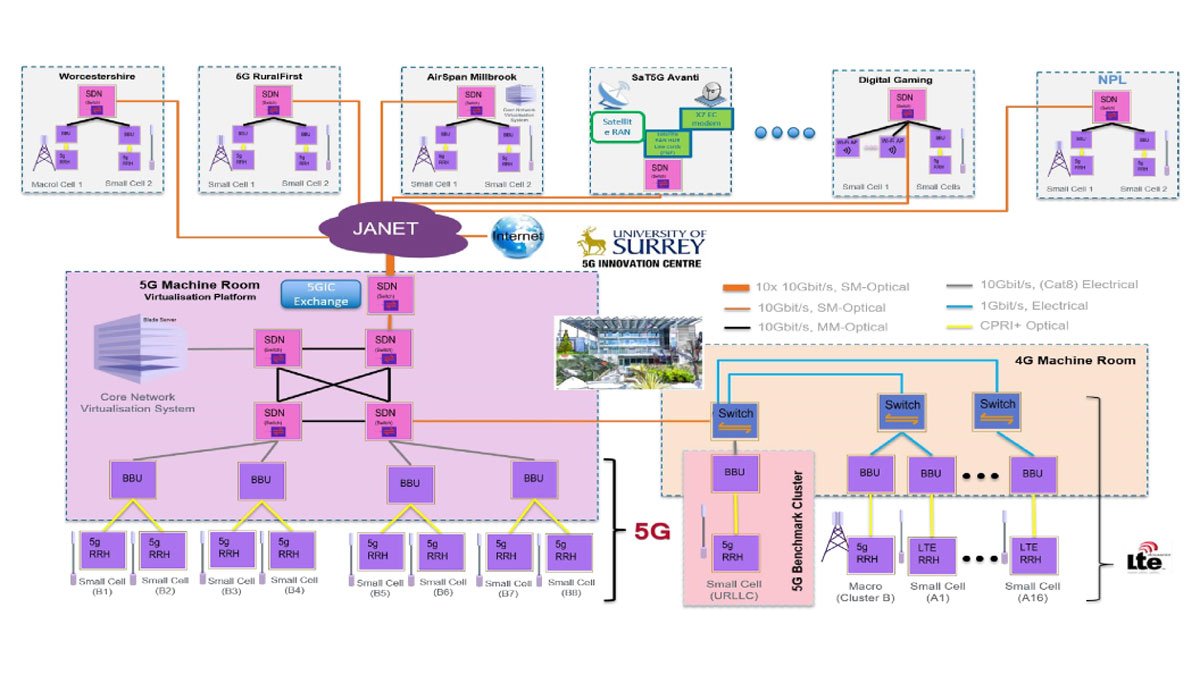
Campus Testbed
The 5G/6G Innovation Centre testbed covers four square kilometres of the Surrey campus and offers 5G infrastructure including 4G and 5G core network, mobile edge computing and access network (such as 4G and 5G radio access network), satellite systems Wi-Fi, and LoRA.
Overview
Our campus testbed supports multiple projects in UK and Europe. Small and medium-sized enterprises (SMEs) are already partnering with us, using the campus testbed to test different aspects of 5G technologies such as 5G applications, cyber security on 5G technology and 5G network slicing.
The testbed has been designed and implemented drawing on the extensive experience of technical experts within the 5GIC as well as industry partners (mobile phone operators, equipment vendors and regulators). It is also open to undergraduate and postgraduate students undertaking 5G projects.
Facilities in detail
Below is a detailed list of our 5GIC testbed and core network facilities, with their key features.
4G and 5G multi-radio access network environment coverage
Outdoor
- Ultra dense C-RAN of 44 4G-TDD sites & 66 Cells
- Cell Cluster operated as 1x Macro and 15 x Small Cell site/Cluster
- eMBB D-RAN of 7 5G-TDD (3.5G) Sites & 9 Cells
- Cell cluster operated as 1x Macro (2.6GHz-TDD) anchor
- 4 x Small Cell (3.5 GHz-TDD) site/Cluster
- URLLC RAN of 1 5G-TDD (3.5G) site and single cell
- 700 MHz 4G-FDD 1 site
- Combination of SDR and 60 GHz supported on a drone for popup-network
- Satellite backhauling
- 60 GHz backhaul system
- Integrated 5G RAN systems on UAV.
Indoor – over two floors
- C-RAN of 4G-TDD 6 Cells
- 4G-FDD femtos cells
- 6 x Wi-Fi-A.
Core network
- Fully containerised cloud native function of Rel-15 4G CUPS core
- Fully containerised cloud native function of Rel-16 5G core with context aware enabled (made in the UK)
- Fully containerised MEC.
5GIC 4G and 5G RAN coverage
The campus testbed RAN at the University of Surrey is designed as an urban ultra-dense network making up over 45 sites supporting both 4G/LTE and 5G-NR technologies in the Non-Standalone (NSA) configuration.
The network supports advanced RAN features such as carrier aggregation, massive multiple-input and multiple-output and Ultra-reliable low-latency communication.
The testbed RAN is used to research and develop advanced algorithms to enhance the user experience in 5G systems. Here, evaluations are done by radio frequency and PHY (physical layer) parameter measurements, as well as advanced network testing tools such as TM500, enabling modelling of many users.
E2E network slicing architecture
We have developed in-house 5G Core (5GC) network functions and conducted several successful demonstrations of slicing using early 5G radio systems. The 5GIC 5GC is currently being updated in accordance with ratified Release 16 standards.
We embrace the 3GPP-defined Service Based Architecture (SBA) and have demonstrated slicing over an CNF-based SBA infrastructure using MANO-based Operations and Administration (OAM).
Currently, the 5GIC testbed supports different slices by service type and market – for example 'Internet of Things', satellite interconnection, and MEC server support. We also configure slices to allowed RANs in terms of 3GPP-5G, non-3GPP Wi-Fi and Satellite interconnected systems.

Diagram showing the 5G Innovation Centre testbed architecture.
Business layer
We operate a business layer software architecture over the MANO control entities. The business layer interacts with the MANO control points of the CNF infrastructure and with the SDN-based transmission network infrastructure to enable network monitoring and visualisation, and provides automation controls for instantiation of a slice.
The four types of service enabled by 5G are:
Enhanced Mobile Broadband (eMBB)
Data-driven use cases requiring high data rates across a wide coverage area. Industry sectors related to this business layer include: Security, gaming, film and music.
Ultra Reliable Low Latency Communications (URLLC)
Strict requirements on latency and reliability for mission critical communications, such as remote surgery, autonomous vehicles or the Tactile Internet. Industry sectors related to this business layer include: Shopping, factory, housing, watch, clothing, cities, animal and sustainability.
Massive Machine Type Communications (mMTC/mIoT)
Need to support a very large number of devices in a small area, which may only send data sporadically, such as Internet of Things (IoT) use cases. Industry sectors related to this business layer include: Travel, electronics, aerodynamics, ferry and traffic.
Vehicle-to-everything (V2X)
Communication is the passing of information from a vehicle to any entity that may affect the vehicle, and vice versa. Industry sectors related to this business layer include: Health, robotics and paramedic.

Diagram showing 5G Innovation Centre testbed and current connected sites.
Get in contact
If you have any questions or are interested in using our facilities, please get in touch.

Dr Suji Gunaratne
5GIC Test Bed Manager

Dr Riccardo Pozza
Chief Network Architect


